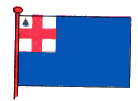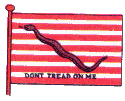 |
Taunton In 1774 the people of Taunton, Massachusetts, resentful of British rule, raised a British battle flag with the inscription "Liberty and Union." |
 |
Bedford At the Battle of Concord in 1775, the Minute Men of Bedford, Massachusetts, carried a flag with a Latin motto meaning "Conquer or Die." |
 | Bunker Hill According to tradition, this New England flag bearing the cross of England and pine tree with its union was carried at the battle of Bunker Hill. |
 | First Navy Jack The field of thirteen stripes with a rattle-snake and motto "Don't Tread on Me" was the device on the jack flown by Commodore Hopkins' fleet when it put to sea in January, 1776. |

| Gadsden Commodore Hopkins flew as his personal pennant a rattlesnake flag presented to him by Colonel Gadsden of South Carolina. |
 |
Liberty Tree In Boston the Sons of Liberty met beneath a huge elm that became known as the Liberty Tree. The Massachusetts Revolutionary flag, designed in 1775 and adopted officially in 1776, used this emblem with teh slogan "An Appeal to God." |
 |
Great Union The Great Unino Flag became the flag of the Continental Army and Continental Navy in Jaunary, 1776. Although never formally adopted by Congress, this flag was used even after the Stars and Stripes became official. |
 |
Bennington The flag of Bennington, Vermont, militia, thought to have been carried at the Battle of Bennington in August, 1777, may have been the first one with thirteen stripes and thirteen stars specified by the Continental Congress on June 14, 1777. |
 |
"Betsy Ross" Flag In its resolution adopting the Stars and Stripes as the national flag, COngress did not state how the stars were to be arranged. The circle, according to legend, designed by Besty Ross, was but one of many arrangements. Legend also states Betsy Ross made the first Stars and Stripes, but this is not true and there is no evidence that she had. Betsy Ross probably did sew quite a few flags, but not the first. |
 |
Fort McHenry The Flag flying above Fort McHenry that Francis Scort Key watched through the "perilous fight" before writing "The Star-Spangled Banner" had fifteen stripes and fifteen stripes. This design was official from 1794 to 1818. |
 |
July 4, 1818 In April, 1818, Congress passed a law returning the number of stripes to the original thirteen and providing that a star for each new state should be added on July 4 following the state's admission. There were twenty stars in the flag that year. Today, we have fifty stars. |
 |
Confederate Battle Flag The Confederate States of American used four flags during the Civil War. The Battle Flag, adopted after the first battle of Bull Run, was the second. The thirteen stars were for the thirteen states claimed by the Confederacy. |
Information on Historic Flags Supplied by New Standard Encyclopedia. Thanks!
Back to Stars and Stripes or Home
Home][Stars and Stripes][Trivia][Symbols